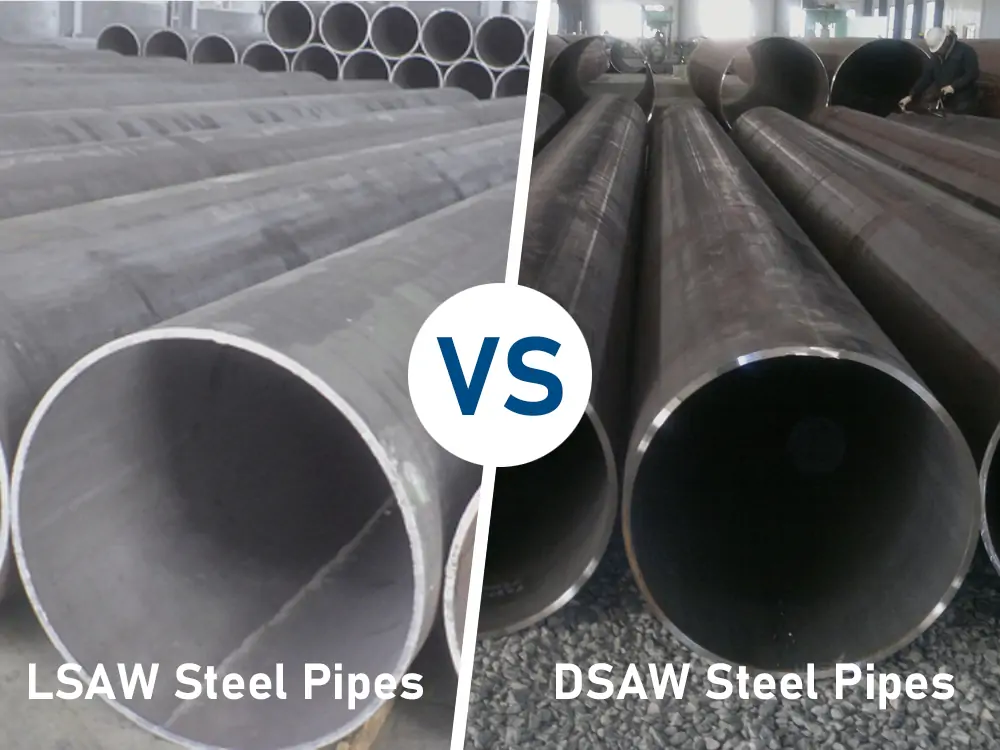Inleiding
Het is niet eenvoudig voor te stellen hoe de olie- en gasindustrie zou functioneren zonder het nut van stalen buizen. Ze zijn van essentieel belang in de bouw en constructietechniek. Onder de verschillende pijplastechnieken in de industrie nemen LSAW en DSAW stalen buizen een speciale plaats in. Dit komt door de ongelooflijke sterkte, duurzaamheid en veelzijdigheid van het proces.
Beide processen zijn vergelijkbaar omdat de techniek voor booglassen onder poederdek wordt gebruikt in beide. Ze verschillen sterk in hun productieproces, gebruik en prestaties.
Dit artikel zal ingenieurs, aannemers en projectmanagers helpen om een balans te vinden tussen kostenefficiëntie, veiligheid en productiviteit.
Inzicht in LSAW stalen buizen
Longitudinaal booglassen onder poederdek (LSAW) buizen beginnen met het buigen van stalen platen in een cilindrische vorm. Vervolgens wordt een naad gelast met behulp van een booglastechniek over de lengte van de cilinder. De populairdere vormen van LSAW zijn UOE (U-vorming, O-vorming, uitbreiding) en JCOE (J-vorming, C-vorming, O-vorming, expansie). Deze methoden garanderen een uitstekende maatnauwkeurigheid en lassterkte.
Kenmerken
- In de lengterichting gelaste buizen met inwendig en uitwendig laswerk op alle niveaus.
- LSAW-buizen zijn geschikt voor gebruik met een aanzienlijke rechtheid, rondheid en maatnauwkeurigheid.
- Vaak verkrijgbaar in superieure wanddiktes van 40 mm en groter.
- De mechanische eigenschappen zijn homogeen door het gecontroleerd vervormen van de platen.
Toepassingen
LSAW-buizen zijn zeer betrouwbaar en worden daarom gebruikt in:
- Offshore boorplatforms.
- Stedelijke watervoorzieningssystemen.
- Hoogwaardige standaardbuizen met zeer stijve constructies voor water- of vloeistofstroming onder hoge druk. Deze stijve buizen worden gebruikt voor zowel onshore als offshore toepassingen.
Inzicht in DSAW stalen buizen
DSAW-buizen worden zowel inwendig als uitwendig gelast via de dubbele onder poederdek lasmethode. In tegenstelling tot LSAW omvat de DSAW-classificatie zowel langsnaadgelast als spiraalgelast. (SSAW) buizen. Stalen platen of rollen worden gewalst en gelast tot een buisvorm, waardoor een robuuste en naadloze verbinding ontstaat.
Eigenschappen van DSAW-pijp
- Diep penetratie en verhoogde hechting sterkte worden bereikt door dubbelzijdig lassen.
- Last grotere diameters, die vaak groter zijn dan 1500 mm.
- DSAW kan dikwandige buizen aan tot 50 mm.
- Vormmethoden en -technieken omvatten flexibele, longitudinale en spiraalvormige benaderingen.
Toepassingen van DSAW-pijp
De unieke eigenschappen en economische voordelen van DSAW-buizen maken ze tot de beste keuze voor gebruik in..:
- Fundering en brugpalen voor de bouw.
- Water- en rioolsystemen in stedelijke gebieden.
- Olie- en gaspijpleidingen met lage tot middelhoge druk.
- Spiraal DSAW voor projecten die lange, doorlopende buizen vereisen.
Belangrijkste verschillen tussen LSAW en DSAW

1. Productieproces
LSAW
Altijd gemaakt door longitudinaal lassen het gevormde product door UOE- of JCOE-methodenDit garandeert uniformiteit en een hoge maatnauwkeurigheid.
DSAW
Met betrekking tot de lasmethode en niet de vormmethode. Geschikt voor longitudinale of spiraalvormige configuraties, waardoor een grotere geometrische flexibiliteit ontstaat.
2. Kwaliteit en sterkte van de las
LSAW
Wanneer één hoogwaardige lasnaad in de lengterichting van een pijp wordt gemaakt, bereikt deze een indrukwekkende mate van structurele integriteit.
DSAW
Met de extra binnen- en buitenlassen wordt de dichtheid van de lassen verhoogd en de spiraallassen resulteren in langere naden, wat het risico op breuken onder zeer hoge spanning kan verhogen.
3. Kosten en productie-efficiëntie
LSAW
Deze pijpen zijn duurder vanwege de complexe vormgeving en strenge kwaliteitscontrole. Toch ideaal voor hoogwaardige projecten.
DSAW
Als deze buizen in grote volumes worden geproduceerd, vooral spiraalgelaste types, zijn ze goedkoper en sneller te produceren. Dit maakt ze voordelig voor grootschalige infrastructuurprojecten.
4. Geometrische flexibiliteit
LSAW
Alleen productie van pijp met rechte naad, meestal met kortere pijplengten (ongeveer 12 m).
DSAW
Er is meer flexibiliteit beschikbaar voor hei- en drainagesystemen, aangezien langere enkele stukken (tot 40 m in spiraalvorm) en er kunnen veel grotere diameters worden geproduceerd.
Voordelen en beperkingen
Voordelen van LSAW-buizen
- LSAW-buizen hebben een hoge dimensionale nauwkeurigheid en consistentie.
- Superieure taaiheid, vervormbaarheid en drukbestendigheid.
- Uitstekend geschikt voor hogedruk- en offshore-toepassingen.
- Er zijn verschillende wanddiktes en diameters verkrijgbaar.
Beperkingen van LSAW-buizen
- Alle productiekosten moeten hoger zijn dan spiraal DSAW.
- Er is meer laswerk per sectie nodig vanwege de kortere lengte die voor elke sectie wordt geleverd.
- Beter geschikt voor toepassingen met verminderde druk.
Voordelen van DSAW-buizen
- Dubbele penetratie van lassen geeft elke verbinding een aanzienlijke sterkte.
- In staat om buizen met grotere diameters en langere lengtes te maken.
- Kostenefficiënter voor grootschalige infrastructuur en bouw
Beperkingen van DSAW-buizen
- Verlies van sterkte door langere lasnaden veroorzaakt door spiraalconstructie.
- Minder maatnauwkeurigheid dan LSAW.
Conclusie
De stalen buizen LSAW en DSAW zijn cruciaal voor industriële en infrastructuurprojecten. Afhankelijk van de eisen van het project kunnen deze buizen op verschillende manieren worden gebruikt.
LSAW-buizen gebruiken
- Wanneer er behoefte is aan constante mechanische eigenschappen.
- Moeten goed presteren onder hoge druk, zoals in een offshore olieplatform of een lange gaspijpleiding.
Selecteer DSAW-buizen
- Wanneer economische overwegingen belangrijk zijn.
- Wanneer een grotere diameter en langere buislengte nodig zijn, in brugpijlers en drainagesystemen.
- Bij het transport van vloeistoffen onder lage druk.
Als ze de verschillen tussen de productietechnieken kennen, kunnen de fabrikanten het meest geschikte type buis kiezen. Dit zal hen helpen de beste balans te vinden tussen prestaties, veiligheid en financieel beheer.
